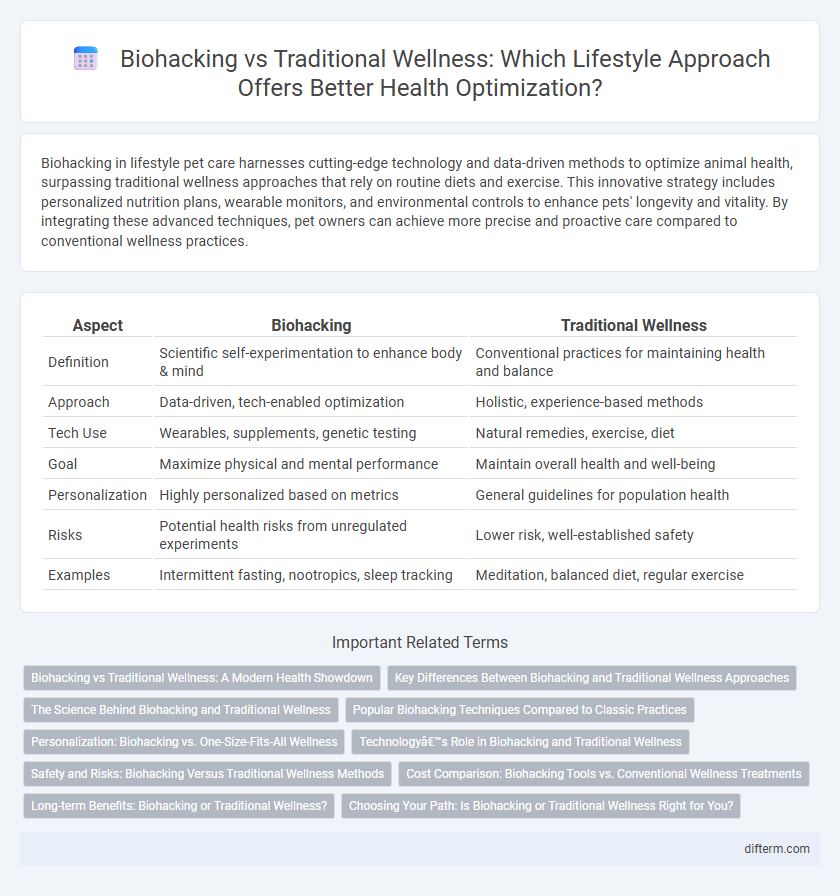Biohacking in lifestyle pet care harnesses cutting-edge technology and data-driven methods to optimize animal health, surpassing traditional wellness approaches that rely on routine diets and exercise. This innovative strategy includes personalized nutrition plans, wearable monitors, and environmental controls to enhance pets' longevity and vitality. By integrating these advanced techniques, pet owners can achieve more precise and proactive care compared to conventional wellness practices.
Table of Comparison
| Aspect | Biohacking | Traditional Wellness |
|---|---|---|
| Definition | Scientific self-experimentation to enhance body & mind | Conventional practices for maintaining health and balance |
| Approach | Data-driven, tech-enabled optimization | Holistic, experience-based methods |
| Tech Use | Wearables, supplements, genetic testing | Natural remedies, exercise, diet |
| Goal | Maximize physical and mental performance | Maintain overall health and well-being |
| Personalization | Highly personalized based on metrics | General guidelines for population health |
| Risks | Potential health risks from unregulated experiments | Lower risk, well-established safety |
| Examples | Intermittent fasting, nootropics, sleep tracking | Meditation, balanced diet, regular exercise |
Biohacking vs Traditional Wellness: A Modern Health Showdown
Biohacking leverages cutting-edge technology and personalized data to optimize physical and mental performance, integrating tools like wearables, nootropics, and genetic testing. Traditional wellness emphasizes holistic practices such as balanced nutrition, regular exercise, mindfulness, and natural remedies rooted in cultural or historical methods. This modern health showdown highlights biohacking's precise, data-driven approach contrasting with the time-tested, nature-based strategies of traditional wellness.
Key Differences Between Biohacking and Traditional Wellness Approaches
Biohacking leverages technology, data tracking, and self-experimentation to optimize physical and cognitive performance, emphasizing personalized interventions like nootropics and wearable devices. Traditional wellness prioritizes holistic practices such as balanced nutrition, regular exercise, and mindfulness techniques rooted in long-standing health traditions. The key difference lies in biohacking's data-driven, experimental methodology versus traditional wellness' emphasis on consistency and natural lifestyle habits.
The Science Behind Biohacking and Traditional Wellness
Biohacking leverages cutting-edge technology and personalized data analytics to optimize physiological functions, often incorporating wearables and genetic testing for tailored health interventions. Traditional wellness relies on time-tested practices like balanced nutrition, regular exercise, and mindfulness, grounded in decades of clinical research and public health studies. Scientific evaluation highlights biohacking's precision approach contrasts with the holistic, evidence-based methodologies of conventional wellness strategies.
Popular Biohacking Techniques Compared to Classic Practices
Popular biohacking techniques such as intermittent fasting, quantified self-tracking, and nootropic supplementation optimize physiological performance through data-driven personalization, surpassing many traditional wellness methods like standard exercise routines and balanced diets that rely on generalized guidelines. Cold exposure therapy, a favored biohack, stimulates cellular resilience and metabolic efficiency in ways conventional wellness rarely addresses. Techniques like red light therapy and neurofeedback further enhance cognitive and physical health, offering innovative alternatives to classic practices focused primarily on nutrition and moderate physical activity.
Personalization: Biohacking vs. One-Size-Fits-All Wellness
Biohacking leverages data-driven insights and cutting-edge technologies to tailor health strategies uniquely to an individual's genetic makeup, lifestyle, and biometric feedback. Traditional wellness often employs standardized routines such as generic diet plans and exercise regimens that may not address personal health nuances effectively. The precision of biohacking enables optimized outcomes by continuously adapting interventions based on real-time physiological responses, contrasting sharply with the one-size-fits-all approach of conventional wellness practices.
Technology’s Role in Biohacking and Traditional Wellness
Technology plays a pivotal role in biohacking by enabling precise monitoring of biomarkers through wearable devices and personalized data analytics, offering tailored interventions for optimizing health. In contrast, traditional wellness relies more on generalized practices such as balanced nutrition, exercise, and mindfulness, often guided by established health principles rather than real-time data. The integration of AI-driven tools and continuous biometric feedback distinguishes biohacking from conventional wellness approaches, enhancing individualized performance and preventative care.
Safety and Risks: Biohacking Versus Traditional Wellness Methods
Biohacking often involves experimental techniques such as nootropics, intermittent fasting, and genetic testing, which can pose unregulated safety risks due to limited scientific validation. Traditional wellness methods--including balanced nutrition, regular exercise, and mindfulness practices--have long-established safety profiles backed by extensive clinical research. Awareness of potential side effects and consulting healthcare professionals remain crucial to minimizing health risks in both biohacking and conventional wellness approaches.
Cost Comparison: Biohacking Tools vs. Conventional Wellness Treatments
Biohacking tools often require a significant upfront investment in technology such as wearable devices, nootropic supplements, and personalized data analytics, which can range from hundreds to thousands of dollars. Conventional wellness treatments like massage therapy, acupuncture, or gym memberships typically involve recurring costs but generally offer more accessible pricing options for ongoing care. Evaluating long-term expenses reveals that biohacking may yield cost-efficiency through personalized and data-driven health optimization, while traditional methods emphasize steady expenditure aligned with routine self-care.
Long-term Benefits: Biohacking or Traditional Wellness?
Biohacking leverages cutting-edge technologies and personalized data to optimize health outcomes, potentially accelerating results through targeted interventions like intermittent fasting, nootropics, and quantified self-tracking. Traditional wellness emphasizes holistic practices such as balanced nutrition, regular exercise, and stress management, fostering sustainable habits that support mental and physical health over a lifetime. Long-term benefits of biohacking may include enhanced cellular function and neuroplasticity, while traditional wellness promotes enduring resilience and disease prevention rooted in time-tested behaviors.
Choosing Your Path: Is Biohacking or Traditional Wellness Right for You?
Biohacking leverages cutting-edge technology and personalized data to optimize physical and mental performance, offering precise control over health variables such as sleep, nutrition, and biomarkers. Traditional wellness emphasizes holistic practices like balanced diet, regular exercise, and mindfulness to maintain overall well-being through time-tested methods. Choosing between biohacking and traditional wellness depends on your goals, openness to technology, and preference for individualized metrics versus natural lifestyle adjustments.
biohacking vs traditional wellness Infographic

 difterm.com
difterm.com